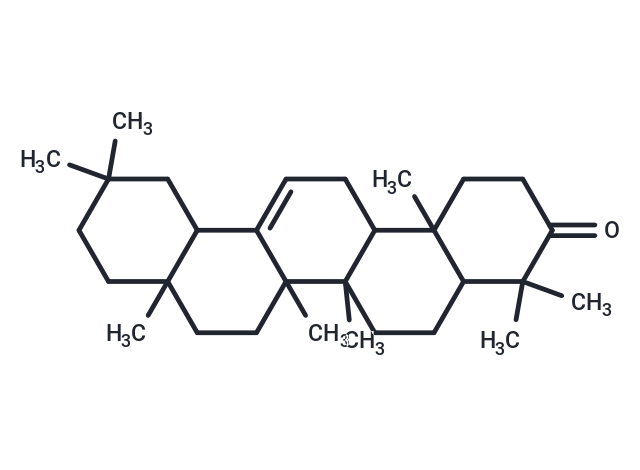Shopping Cart
- Remove All
 Your shopping cart is currently empty
Your shopping cart is currently empty

beta-Amyrone (β-Amyron) has antifungal activity against Chikungunya virus replication with an EC50 of 86 uM. beta-Amyrone has anti-inflammatory activity through inhibiting the expression of COX-2. beta-Amyrone exhibits anti-α-glucosidase inhibitory activity and moderate AChE activity. β-Amyrone can be used in the research of disease like inflammation, infection, and obesity.

| Pack Size | Price | Availability | Quantity |
|---|---|---|---|
| 1 mg | $122 | In Stock | |
| 5 mg | $372 | In Stock | |
| 10 mg | $597 | In Stock | |
| 25 mg | $935 | In Stock | |
| 50 mg | $1,260 | In Stock | |
| 100 mg | $1,690 | In Stock | |
| 500 mg | $3,380 | In Stock |
| Description | beta-Amyrone (β-Amyron) has antifungal activity against Chikungunya virus replication with an EC50 of 86 uM. beta-Amyrone has anti-inflammatory activity through inhibiting the expression of COX-2. beta-Amyrone exhibits anti-α-glucosidase inhibitory activity and moderate AChE activity. β-Amyrone can be used in the research of disease like inflammation, infection, and obesity. |
| In vitro | beta-Amyrone inhibits α-glucosidase AChE and fungal activity with IC50 values of 25 μM, 23 μM and 8 μg/mL, respectively[1]. In LPS-stimulated J774 cells, beta-Amyrone (2.5, 5, 10 μg/mL) inhibits NO production with an IC50 value of 4.61 μg/mL without obvious effects on cell viability[4]. beta-Amyrone (10 μg/mL) inhibits IL-6, IL-10 levels, and COX-2 expression at the dose of 10 μg/mL[4]. |
| In vivo | In ear phenol-induced edema in Balb C mice, beta-Amyrone (0.1, 0.3, 0.6 mg/kg) inhibits ear edema formation in a dose-related manner[4]. |
| Alias | β-Amyron |
| Molecular Weight | 424.7 |
| Formula | C30H48O |
| Cas No. | 638-97-1 |
| Smiles | CC1(C)CCC2(C)CCC3(C)C(=CCC4C5(C)CCC(=O)C(C)(C)C5CCC34C)C2C1 |
| Relative Density. | 1.31g/cm3 |
| Storage | Powder: -20°C for 3 years | In solvent: -80°C for 1 year | Shipping with blue ice. |
| Solubility Information | DMSO: Insoluble Ethanol: <0.1 mg/ml (insoluble) |

Copyright © 2015-2025 TargetMol Chemicals Inc. All Rights Reserved.